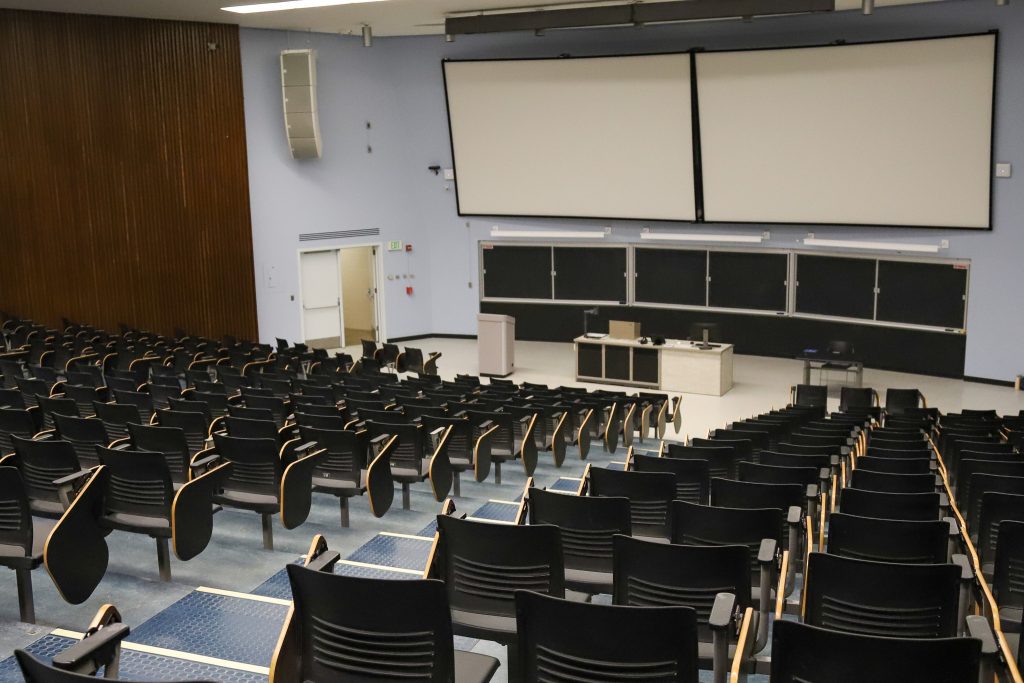Details of BU’s new lecture hall and classroom building were discussed in the first of two planning sessions.
After receiving $60 million in funds from the SUNY Construction Fund (SUCF) last December, BU plans to build its new lecture hall by fall 2026. An information session was hosted on Thursday by James Pitarresi, vice provost for online and innovation education, and Michelle Ponczek, director for course building and academic space management.
Around 15 faculty members from a variety of departments — including math, biology, fine arts, political science and English — gathered to discuss their ideas on technology, seating arrangements, writing surfaces, room configuration, lighting and other building amenities.
Ponczek explained the importance of the new lecture hall, with the project currently in the planning and programming stage.
“A new lecture hall and classroom building has been a priority for several years,” Ponczek wrote in an email. “Our largest classrooms are in very high demand. Having this new building will help alleviate that and allow us to take classrooms offline for technology and other upgrades and advance other renovation projects where classrooms will be converted to other uses.”
The meeting began with an attendee asking what would happen with existing classrooms if classes are moved to the new building. Ponczek replied that some of the existing buildings, including the Fine Arts building, would go into renovations.
Attendees were also curious about how the planning committee plans to differentiate the classrooms, with some asking if different classrooms would have unique setups and teaching conditions. Pitarresi replied that it would depend on faculty demands and expectations, such as flexible furniture.
The meeting then went on to deliberate on the different tables, chairs and desks that should be implemented.
Faculty members also expressed concern with current classrooms. One professor said some classrooms need more room for instructors to walk around and interact with students. Another professor said the primary concern of his department was the high demand for classrooms that can accommodate 100 or more students — and the low supply of classrooms capable of fitting such numbers. The professor suggested the planning committee look at each department’s demand for the size of the new classrooms.
Ponczek said the planning committee will organize a list of details on room types and building features after the sessions.
“At this time, we are planning for a 300-seat and a 180-seat lecture hall, a 100-seat active learning classroom, three computer pod classrooms, 20 or more classrooms ranging in size from 20 to 75 seats, group studying rooms, printing stations and open student study areas,” Ponczek wrote.
Technological issues were also discussed in the meeting. Each faculty member shared a request, some preferring conventional chalkboards while others were favoring new Smart Boards. Varying thoughts about the size, number and quality of classroom screens were shared during the meeting, as well as ideas about floor outlets, maintenance staffing, room selection and classroom renovations.
Pitarresi reflected on the demands raised and explained that he was trying to find optimal solutions.
“I think what I am hearing is that there will be no perfect classrooms,” Pitarresi said. “There are going to be trade-offs. [Some features] will be functional and work well for the disciplines, and [others] will not be so great. What we are trying to do is not-so-great to be better.”
The information sessions ended with final comments on the new lecture hall’s features. Planning committee members said they hoped faculty would come to the new lecture hall before its official opening and provide final feedback.
Brian Kim, a sophomore majoring in computer science, described his reservations about the construction of the new lecture hall.
“I think having a new building will be very motivating for people, and it will create a healthy, promotional environment,” Kim said. “Still, I hope that the University spends more [money] on improving students’ food quality and living situation.”
Tim Ahn, a sophomore majoring in graphic design, said students should also be heard and be involved in the new lecture hall planning.
“Students, first of all, are the most important people who pay tuition here,” Ahn said. “I would like to hear more about what this campus is planning to entail, input our thoughts into it and get our opinions heard about the campus.”



